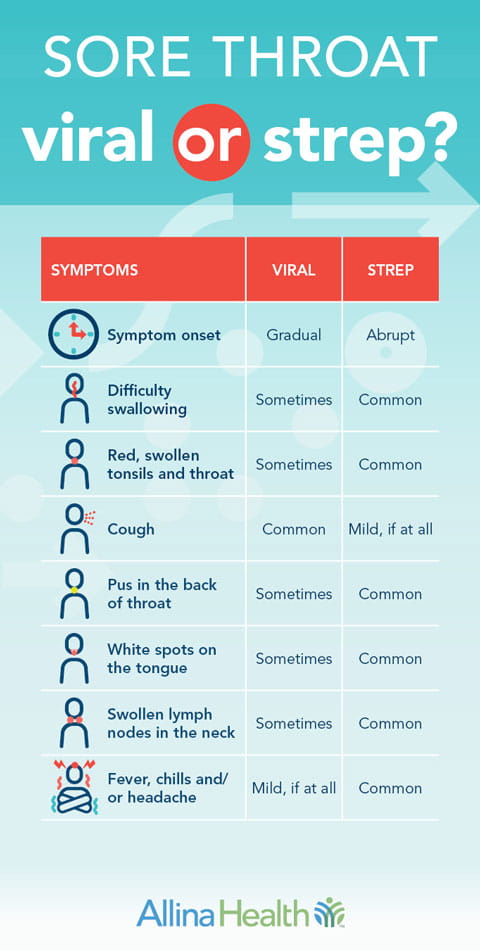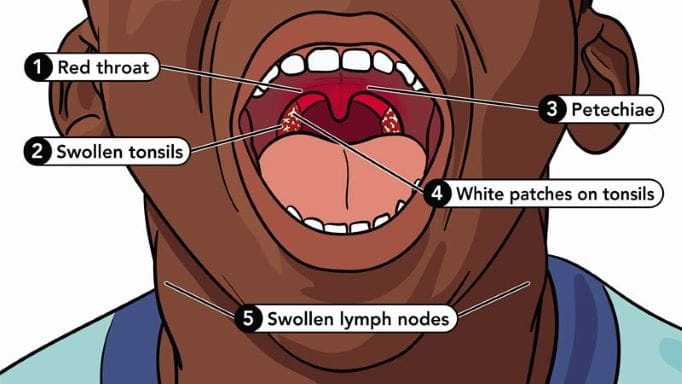It’s bad enough when a scratchy, sore throat makes you or your child feel miserable – but when the issue could be strep, it becomes more than a nuisance and can get very serious.
Not only does strep throat spread easily to classmates, friends and family members – it can also lead to severe illness if not treated with antibiotics.
What is strep throat?
Strep throat is an infection of the throat and tonsils. It is cause by group A Streptococcus bacteria, unlike most sore throats caused by viruses. Strep throat occurs throughout the year, but is most common during winter and early spring.
While viral sore throats usually resolve on their own, strep throat should be treated with oral antibiotics to reduce the risk of complications. These include conditions like rheumatic fever or other autoimmune diseases, which can damage the heart valves, kidneys and joints.
Although adults can get strep throat, kids get it more often because they are regularly together in school and other group settings where the bacteria can easily get passed around.
Can you get strep throat without tonsils?
You can get strep throat even if you no longer have your tonsils. However, not having them may reduce the severity or frequency of strep throat infections.
Symptoms of strep throat
You may have all or most of these common symptoms or just a few:
- fast onset of symptoms
- red, sore throat
- swollen tonsils
- patches of white pus on tonsils
- fever
- difficulty swallowing
- chills
- headache
- bad breath
- nausea and vomiting
Additional symptoms may include:
- rash on body
- stomach pain
- fatigue

Here is the infographic comparing symptoms of strep throat or a viral sore throat in an alternative format.
What does strep throat feel like?
Strep throat can feel like a bad cold that comes on fast. People with strep throat often have a very sore, swollen throat and may have difficulty swallowing. They may also have a fever that makes them feel rundown.
What does strep throat look like?
Swelling of lymph nodes in the neck and swelling in the tonsils are common symptoms that I look for in patients who may have strep. I also check for white patches or streaks of pus on the tonsils and tiny, red dots – a condition called petechiae – on the roof of the mouth. These symptoms can indicate strep throat.

Strep throat vs. sore throat
The bacteria that causes strep doesn't usually affect the lower respiratory tract, so there's no phlegm being coughed up. The presence of a cough can mean that the sore throat is viral, not bacterial, and as such is not strep-related.
Is strep throat contagious?
Strep throat is very contagious. Once infected, it can take several days to develop symptoms. The disease can spread to others a few days before symptoms start, and it remains contagious until you have been on antibiotics at least 24 hours.
How strep throat spreads
When someone with strep throat coughs or sneezes, it spreads respiratory droplets containing the bacteria. If droplets get on your hands and then you touch your mouth, nose or eyes, you can end up with strep throat.
Steps to prevent the spread
If you or someone in your family has strep throat, wash your hands frequently to remove any bacteria present. Avoid sharing common household items, especially plates, glasses and utensils. Remind people to cover their mouth and nose when coughing or sneezing.
Treatment for strep throat
Strep throat is diagnosed using a rapid strep test. Your health care provider swabs the back of the throat and tests the swab for the bacteria that causes strep. The results are available in minutes. Your provider may also confirm a diagnosis with a throat culture. A culture takes more time but can find infections missed by a rapid strep test.
If the results are positive, your provider will likely prescribe amoxicillin or penicillin – two antibiotics that work well on the strep bacteria and usually have few serious side effects. Not only do antibiotics prevent the complications of strep throat, but they also ease symptoms quicker. But even if you or your child feels better, it's important to finish the entire antibiotic prescription.
How long does strep throat last?
Most people who receive antibiotics for strep throat feel better within 48 hours. It can take a little longer depending on the severity of your illness, your immune system and how much rest you are getting.
Does strep throat go away on its own?
Strep can go away on its own, but there are risks for serious complications, especially in children. Antibiotics can prevent these issues and bring relief from common symptoms to make it more comfortable to recuperate.
Can you test for strep throat at home?
While there are some at-home tests available for strep, it can be difficult to ensure you're swabbing the throat correctly, especially with an uncooperative child. The Centers for Disease Control and Prevention (CDC) recommends talking to your health care provider if you or your child has a sore throat or any other concerning symptoms.
When can I return to normal interactions?
The CDC recommends staying home from work, school or daycare until the person with strep is fever-free and has taken antibiotics for at least 12 to 24 hours. Your healthcare provider may have more specific recommendations.
How to soothe strep throat at home
A body that's fighting off bacteria like strep needs rest to heal and recharge. Try to get long periods of quality sleep and find ways to stay hydrated. These additional suggestions may also help you feel better.
Non-prescription pain medicine
Always use over-the-counter medicines as directed when attempting to relieve pain and discomfort. Some cold medications are not recommended for children of certain ages due to the risk of serious and sometimes life-threatening side effects in young children. Ask your doctor or pharmacist about appropriate medicines and doses.
Gargling
If a child is old enough to hold and swish water around in their mouth, gargling can help to reduce pain. Stir together a simple mixture of 1/4 teaspoon salt and 8 oz. of warm water to create a homemade mouthwash. Gargle with the mixture three times a day until symptoms subside.
Warm liquids
This is a case when grandma's remedy – a bowl of chicken soup – can be good medicine. Warm, salty fluids like those in soups and broths can sooth sore throat tissues.
Homemade freezer pops
If it's difficult to drink big gulps of liquid, consider freezer pops made from sports drinks that include electrolytes. They can give you a small amount of glucose in the water that you need to stay hydrated, and the coolness can help to soothe the soreness in the throat.








